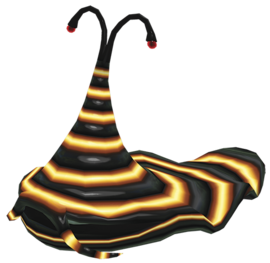Pyroclasmic Slooch
| Pyroclasmic Slooch | |
|---|---|

| |
| Appears in | Pikmin 3 |
| Scientific name | Unknown |
| Family | Unknown |
| Areas | Distant Tundra |
| Mission Mode Collect Treasure! stages | None |
| Mission Mode Battle Enemies! stages | None |
| Side Story days | None |
| Bingo Battle stages | None |
| Attacks | Eats Pikmin
Burns Pikmin |
The Pyroclasmic Slooch is an enemy found in Pikmin 3, first seen at Nintendo's E3. It is resembles a black slug-like creature with yellow light pulsing down its body. It is somewhat cone-shaped with two small antennae at its tip. It cloaks itself in flames which will set any non red Pikmin on fire if they make contact with it. It moves slowly, leaving a flaming trail of fire behind it that can further ignite Pikmin. Its face consists of two small eye stalks, and a long grey-blue tongue which it can lash out to snatch Pikmin from a medium range. It is only hurt by Red Pikmin, because they are immune to fire but can also be hurt by other Pikmin if it goes into the water. While a Rock Pikmin's initial thump can damage it, they will quickly catch on fire. When killed, their flaming bodies extinguish, and shrink.
The Pyroclasmic Slooch will sometimes act as a hazard. By leaving trails of fire, it has the ability to block areas for non-red pikmin, which will only be accessible if they are defeated by Red Pikmin. It takes 3 Pikmin to carry and is worth 15 Pokos.
Killing Strategy
Killing the Pyroclasmic Slooch is simple. Take some Red Pikmin, any amount, and throw it onto it's body. The Red Pikmin should be able to kill it very quickly, but occasionally, it might eat around 1 or 2 Red Pikmin.
Notes
Pikmin 3 Website
"These slow-moving creatures use fire to keep away potential predators. They also use their tongues to reel in prey."
Gallery
- Pyroplasmic Slooch.jpg
Two Pyroclasmic Slooches being attacked by Charlie and his group of Red Pikmin.
- Pyroplasmic slooch.JPG
A Pyroclasmic Slooch in the demo, showing it's beta name, Pyroplasmic Slooch.
- UE1.png
Alph and group of Rock Pikmin near a group of Pyroclasmic Slooches.
- Zoom Pyroplasmic Slooch.png
Zooming in on a Pyroclasmic Slooch.
Trivia
- It is possible that the name may be a pun of a pyroclastic flow, a fast moving current of hot gas or rock commonly found in volcanoes. This would make sense as these appear to be made of magma.
- Its beta name was "Pyroplasmic Slooch," a one-letter difference between its current name.